| Figure 1A: Net operating and fiscal balance | Figure 1B: Net capital investment |
 |
 |
| The national net operating balance is forecast to improve across the forward estimates as Australia continues to emerge from the impacts of the COVID-19 pandemic. | |
| Figure 1C: Revenue and expenses* | Figure 1D: Net debt |
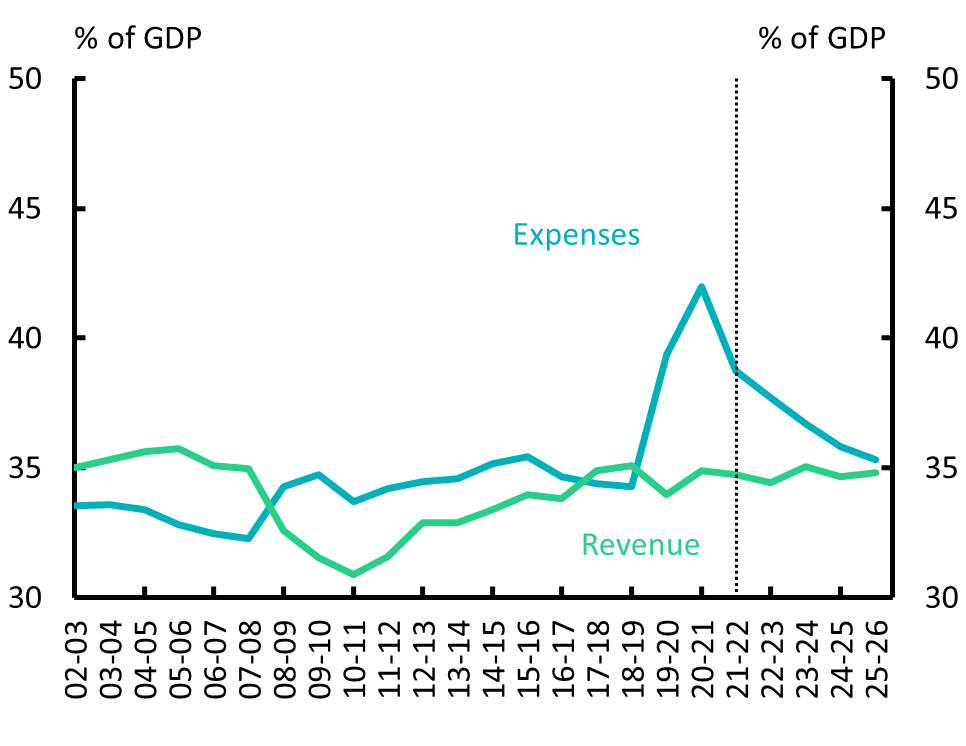 |
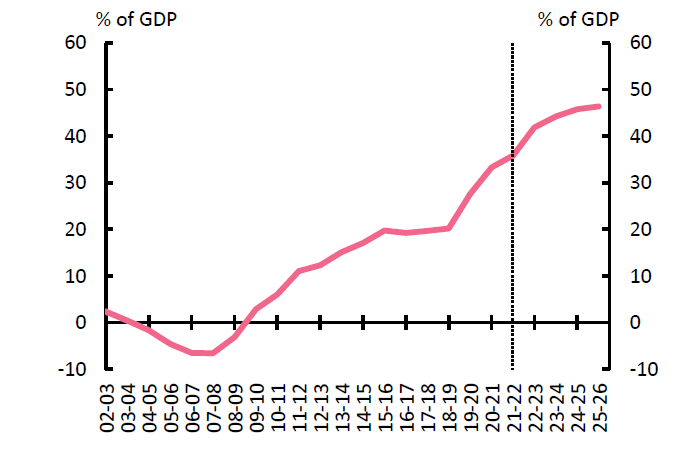 |
| However, continued operating deficits will necessitate borrowing for most governments, increasing national net debt across the forward estimates. | |
| Figure 1E: Net financial worth | Figure 1F: Public debt interest payments |
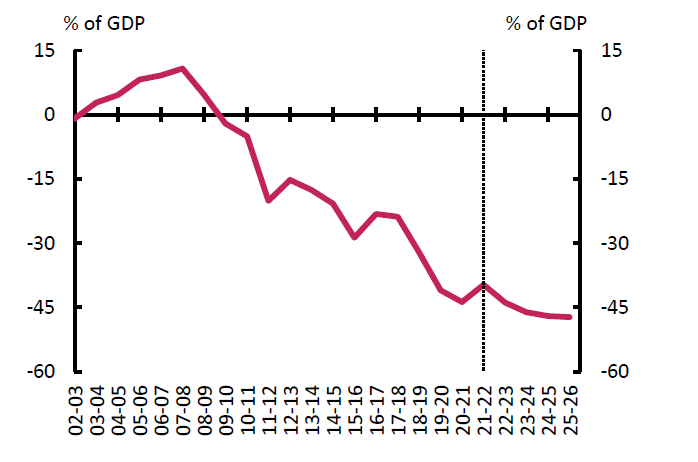 |
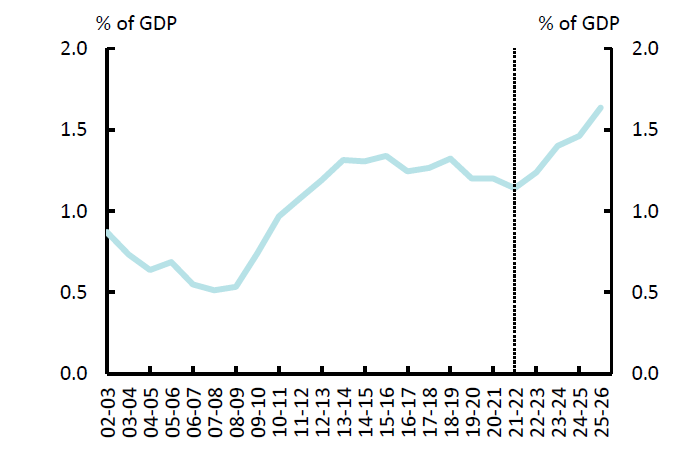 |
| Public debt interest repayments are expected to increase across the forward estimates due to the increase in debt and interest rates. | |
*Figure 1C was updated on 11 May 2023 to correct an error. The chart data in the accompanying excel spreadsheet is unaffected.
| Figure 2A: Net operating and fiscal balance | Figure 2B: Net capital investment5 |
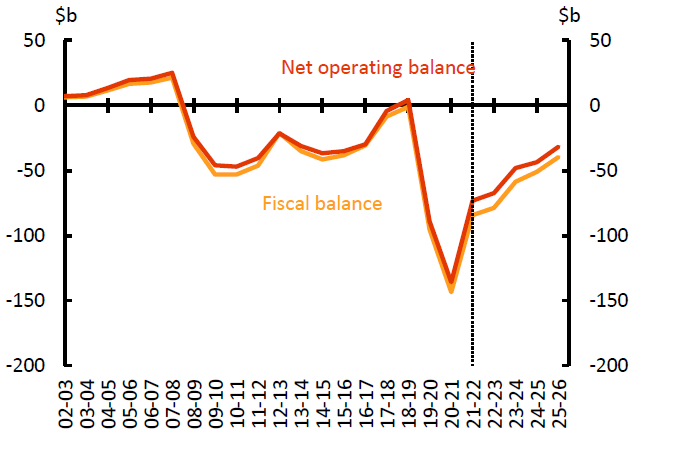 |
|
| With stronger-than-expected momentum in the labour market and consumption, the Australian Government forecasts an improvement in the net operating balance over the forward estimates. | |
| Figure 2C: Revenue and expenses | Figure 2D: Net debt |
| With rising debt and increasing interest rates, public debt interest payments are expected to grow across the forward estimates. | |
| Figure 2E: Net financial worth | Figure 2F: Public debt interest payments |
| Public debt interest repayments are expected to increase across the forward estimates due to the increase in debt and interest rates. | |
| Figure 3A: Net operating and fiscal balance | Figure 3B: Net capital investment |
| The New South Wales Budget forecasts a significant increase in net capital investment in 2022-23 and 2023-24, with large investments in transport, hospitals and school infrastructure. | |
| Figure 3C: Revenue and expenses | Figure 3D: Net debt |
|
Expenses are expected to fall across the forward estimates as temporary support programs in response to COVID-19 and flood assistance measures are phased out. |
|
| Figure 3E: Net financial worth | Figure 3F: Public debt interest payments |
| With rising debt due to operating deficits and increasing interest rates, public debt interest payments are also expected to increase. | |
| Figure 4A: Net operating and fiscal balance | Figure 4B: Net capital investment |
| Victoria’s Big Build continues, but the COVID-19 pandemic continues to create some uncertainty around the state’s capital program. | |
| Figure 4C: Revenue and expenses | Figure 4D: Net debt |
|
Expenses are expected to peak in 2021-22, then fall across the forward estimates. |
|
| Figure 4E: Net financial worth | Figure 4F: Public debt interest payments |
| With rising net debt and increases in interest rates, Victoria’s public debt interest payments are expected to grow substantially across the forward estimates. | |
| Figure 5A: Net operating and fiscal balance | Figure 5B: Net capital investment |
| Queensland Budget demonstrates a net operating surplus for 2021-22, driven by the revenue impacts of higher coal and oil prices and increase in housing activity. | |
| Figure 5C: Revenue and expenses | Figure 5D: Net debt |
|
However, expenses are expected to increase in 2022-23 as a result of spending on health, education and flood recovery measures. |
|
| Figure 5E: Net financial worth | Figure 5F: Public debt interest payments |
| Queensland’s public debt interest payments are expected to grow across the forward estimates driven by increasing interest rates. | |
| Figure 6A: Net operating and fiscal balance | Figure 6B: Net capital investment |
| Western Australia expects an operating surplus over the forward estimates period, as the state continues to benefit from high commodity prices. | |
| Figure 6C: Revenue and expenses | Figure 6D: Net debt |
|
Revenue is forecast to decrease from 2022-23 as iron ore prices return to their long-run average in 2023-24. |
|
| Figure 6E: Net financial worth | Figure 6F: Public debt interest payments |
| Public debt interest payments are forecast to fall from 2021-22, as the state continues to expect operating surpluses and net debt to remain relatively stable over the forward estimates. | |
| Figure 7A: Net operating and fiscal balance | Figure 7B: Net capital investment |
| South Australia Budget forecasts net operating surpluses from 2022-23 onwards, with revenues exceeding expenses. | |
| Figure 7C: Revenue and expenses | Figure 7D: Net debt |
|
However, net debt is still forecast to grow over the forward estimates period due to ongoing substantial infrastructure investment. |
|
| Figure 7E: Net financial worth | Figure 7F: Public debt interest payments |
| With the expected increase in net debt and increasing interest rates, South Australia’s public debt interest payments are expected to increase across the forward estimates. | |
| Figure 8A: Net operating and fiscal balance | Figure 8B: Net capital investment |
| Tasmania forecasts a significant increase in net capital investment, driven by spendings on roads and bridges, housing and health. | |
| Figure 8C: Revenue and expenses | Figure 8D: Net debt |
|
Net debt is expected to increase across the forward estimates, mostly due to the state’s COVID-19 recovery measures and the strong pipeline of infrastructure investment. |
|
| Figure 8E: Net financial worth | Figure 8F: Public debt interest payments |
| Increases in the debt level and interest rates are expected to drive an increase in public debt interest payments across the forward estimates. | |
| Figure 9A: Net operating and fiscal balance | Figure 9B: Net capital investment |
| The Australian Capital Territory forecasts net operating deficits across the forward estimates, as the state continues to invest in their largest ever capital works program. | |
| Figure 9C: Revenue and expenses | Figure 9D: Net debt |
|
Expenses are forecast to exceed revenue across the forward estimates, with net debt increasing as a positive share of GDP from 2021-22. |
|
| Figure 9E: Net financial worth | Figure 9F: Public debt interest payments |
| With rising debt and increases in interest rates, the territory’s public debt interest payments are forecast to increase across the forward estimates. | |
| Figure 10A: Net operating and fiscal balance | Figure 10B: Net capital investment |
| The Northern Territory Budget forecasts net capital investment to increase significantly in 2022-23 as a result of infrastructure spending. | |
| Figure 10C: Revenue and expenses | Figure 10D: Net debt |
|
The territory is projected to reach a minor operating surplus in 2024-25 and 2025-26, such that net debt is expected to peak over the forward estimates, before gradually decreasing. |
|
| Figure 10E: Net financial worth | Figure 10F: Public debt interest payments |
| The territory’s net financial worth is forecast to show a gradual increase from 2024-25 onwards, as net debt begins to fall. | |
- This snapshot accompanies the PBO’s 2022-23 National fiscal outlook report. Data from 2002-03 to 2020-21 are sourced from the Australian Bureau of Statistics’ (ABS) Government Finance Statistics, Annual publication. The variance in Government Finance Statistics from the Australian Bureau of Statistics (ABS) and state budgets is due to an adoption of newer accounting standards in government financial reporting. Other divergences may occur due to timing recognition and other conceptual determination differences. Estimates and forecasts for 2021-22 to 2025-26 are sourced from Australian, state, and territory budgets. Further information about the data, methods, and terms used in this snapshot is available in the technical appendix.
- Net capital investment does not include government businesses. Net capital investment includes the transfer of fixed assets to other sectors of government.
- The 2022-23 Budget forward estimates period is 2022-23 to 2025-26.
- National charts include Australian, state, territory, and local government estimates and forecasts. Transfers have been eliminated between levels of government to arrive at a consolidated national fiscal position.
- The Australian Government also provides funding to the states for infrastructure projects through grants, equity injections and debt financing, which are not captured in direct Australian Government investment.
- New South Wales estimates and forecasts for revenue and expenses have been adjusted by the PBO to improve comparability through time and across jurisdictions. The budget estimates published by New South Wales exclude Australian Government transfers that ‘pass through’ their state accounts and, as such, their reported revenue and expenses do not include these amounts. In contrast, the ABS requires that the full ‘grossed up’ amount be reported. Revenue and expenses for New South Wales from 2021-22 onwards are adjusted using the estimates of these transfers in state and Australian Government budget papers.
- Western Australian estimates are forecasts for revenue and expenses have been adjusted by the PBO to improve comparability through time and across jurisdictions. The budget estimates published by Western Australia exclude Australian Government transfers that ‘pass through’ their state accounts and, as such, their reported revenue and expenses do not include these amounts. In contrast, the ABS requires that the full ‘grossed up’ amount be reported. Revenue and expenses for Western Australia from 2021-22 onwards are adjusted using the estimates of these transfers in state and Australian Government budget papers.
- The Australian Capital Territory’s estimates and projections of net debt have been adjusted by the PBO to be consistent with the Uniform Presentation Framework.
National fiscal outlook: As at 2022-23 Budgets
The full version provides a national perspective on the fiscal outlook by examining outcomes across all levels of Australian government.